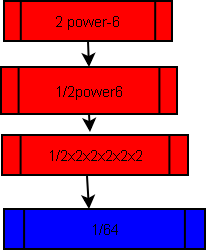Lesson 3: Zero and Negative Indices
| Topic 1: Indices and Logarithms | |
|---|---|
| Indices and Logarithms | Lesson 1: Bases and Indices | Lesson 2: Fractional Indices | Lesson 3: Zero and Negative Indices | Lesson 4: Exponential Equations | Lesson 5: Definition and Laws of Logarithms | Lesson 6: Equations Involving Logarithms | Lesson 7: Introduction to Surds | Lesson 8: Linear Equations | Lesson 9: Simultaneous Equations | Lesson 10: Simple Linear Equations |
Introduction
You have already learnt from the beginning of the topic that an index form is an easy way of writing down numbers.Let us take a look at the example 34.The number 4 is called the index and the number 3 is the base. so 40 also indicates that 0 is the index and 4 is the base. The index which is also called the power or exponent can be positive, negative or zero.
By the end of this lesson you should be able to
|
Lesson Content
Let us now consider the zero index. Here is an example.b5/b5.This as you have already learnt is solved by maintaining the base and subtracting the second index from the first.In this case is b5-5=b0.Also it can be solved as b5/b5=1.Because of these two scenario it is logical to conclude that any number or letter raised to power zero equals one.Now try to find answers to the following:
- 70
- 900
- a0
If you remember well then all the answers will be 1.If you got the right answers then BRAVO you have made a great progress. Let us now take a look at the negative indices.a3/a7.This is the same as a3-7 which is equal to a-4.a-4=1/a4.We can now agree also that any number or letter raised to a negative index can be written as 1 divided by the positive power in question.For instance r-5= 1/r5simplying further 1/r5=1/rxrxrxrxr.Let us now use numbers. 2-6=1/26 1/26=1/2x2x2x2x2x2
=1/64
Illustration.
 Try these without looking at the solutions.
(1/2)-3, y-4
Try these without looking at the solutions.
(1/2)-3, y-4
Let us find out together. 1/2-3=1/(1/2)3
=1/1/8
=1x8/1
=8
y-4 = 1/y4
=1/yxyxyxy
How did it go? Hope you got the answers.